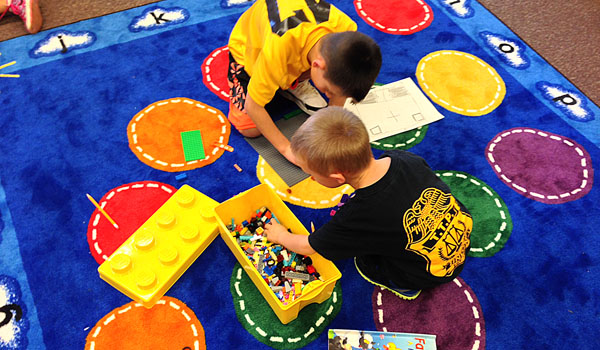Legos allow students to creatively learn at St. Andrew's
by KIMBERLEE SABSHIN
At St. Andrew's Country Day School in Kenmore, Legos, the perennial favorites of children and adults alike, have become a tool for STREAM education instructing children in the fields of science, technology, religion, engineering, arts and math. Throughout the months of October and November, the school held an eight-week after school course, the Lego U STREAM Academy, to teach children in lower grades to collaborate with one another, use critical thinking skills and have fun in the process of learning.
During each session, children were given assignments and problems to solve and, after splitting up into groups, were to use the blocks to create models that satisfied requirements. On Oct. 19, they used Legos to build churches, with some building flat ones and others opting for 3-D models, on designated boards.
Mary Augustine, a second-grade teacher and STREAM coordinator at St. Andrew's, said the school has been involved with STREAM for three years, having been selected as one of 10 pilot schools to start implementing the curriculum into lessons. Although not all the teachers ran STREAM academies after school, the curriculum is also included in regular classes from children in pre-K through grade eight.
"Last week, they did a story on the seven days of creation, and they had to use the Legos to build what was done on each of those days, like the animals, nature and the sun," she said. "It's a lot of teamwork and working together, and probably, the most fun thing is that it's all hands-on. They get to build, and it's not paper and pencil. The great thing is that we're incorporating religion into it, like the Bible stories."
According to Augustine, Legos provide an alternative way for children to get involved with the lessons, beyond simply listening to a teacher stand in the front of the room and talk to them, which Augustine said has been the best part of the STREAM academy. "They absolutely love it," Augustine added. "If you notice, they're not fighting. It does require teamwork. It requires cooperation and listening to one another, conflict resolution, and listening to other people's ideas and working things out the best way you can."
"A lot of times, you think your ideas are the best ideas - and really, when we listen to each other, there are ideas that maybe we never thought of, or someone's ideas could be a little bit better than ours, or could complement ours. It's collaborative working, teamwork, and they're excited to work on the projects. They're excited to try to figure things out. A lot of it is their own discovery, student discovery. It's not the teacher telling them the solution. It's the teacher posing a problem, and the students work together to solve it."
Pam Giannantonio, a first-grade teacher, said that when she gave her students the assignment to build a church, they were told only that it had to be a building, whether inside or out, with four walls.
"They had to do their own little blueprint. With their partner, they drew out a picture of what they intend to build. From that blueprint, they now are building something of the church," Giannantonio explained. "They're with somebody different each week, so there aren't the same idea structures from the same two kids - boys with girls, girls with boys. This is first and second grade, so I have a mix of a first-grader with a second-grader, sometimes first grade with first grade, second grade with second grade. I try to mix them."
When asked about the advantages of using Legos for STREAM learning, Giannantonio said they allow students the possibility of "endless" creativity. When they first started the assignments, she asked students to build their names in Legos, and she got many different results. While most children built them in flat blocks on the boards, others did it in 3-D. "It really allows them to think outside the box," she said.
At St. Andrew's, children in various grade levels joined by signing up for the fall STREAM academies, with the younger children working with Legos and older ones being given more complex and age-appropriate lessons, with the oldest students learning about robotics, which Augustine said is popular. They also built rollercoasters, launched rockets and built structures to protect eggs from high falls. In December, the students will go to an annual STREAM competition at St. Joseph's Collegiate Institute in Kenmore.
"I feel fortunate that we can offer it to our children. It's just as wonderful as offering a sport or any kind of afterschool club. It's learning, and they don't even realize," Augustine concluded.




